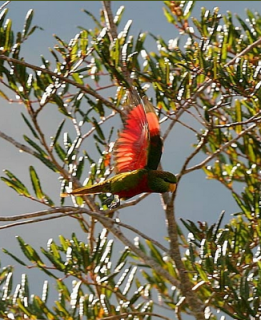Musschenbroek’s Lorikeet |
|
|
Also known as: Yellow-billed Lorikeet, Yellow-billed Mountain Lory, Alpine Lorikeet
Photos
View in GalleryDid You Know?
The Musschenbroek's or Yellow-billed Lorikeet is often observed to run "rodent-like" along branches, keeping its head down as it does so.Academic Research
Related publications: Neopsittacus musschenbroekiiSpecies Profile
Genus: Neopsittacus | Species: musschenbroekii
Size:
23cm (9 in)
Weight:
43-55g (1.5-1.9 oz)
Subspecies including nominate:
three: N.m. musschenbroekii, N.m. medius, N.m. major
Colour Adult:
N.m. musschenbroekii: Both adults in general green; olive/brown crown and nape, streaked with dull yellow; olive/brown hindneck and cheeks, the cheeks streaked pale green; red throat to centre of abdomen; red underwing coverts and underwing band; green uppertail tipped with yellow, orange/yellow undertail with red at base of lateral feathers. Bill pale yellow. Eye red.
N.m. medius: Both adults as in musschenbroekii, but larger in size; more yellow streaking on cheeks.
N.m. major: Both adults as in medius, but plumage in general paler; red underparts; green/yellow streaking on cheeks.
Colour Juvenile:
N.m. musschenbroekii: In general duller than adults; green throat and upper breast marked with red; green lower breast. Bill pale brown tipped with yellow. Cere yellow.
N.m. medius: As in adults.
Call:
Calls made when perched are two-syllable screeches, the second note being lower than the first. Also musical three-note calls with downward inflection. Call notes lower-pitched, nasal and hollow sounding.
Listen NowVideo Links:
Video 1More Information:
Content Sources:
CITES
BirdLife International
Cornell Lab of Ornithology/Birds of the World
Parrots: A Guide to Parrots of the World, Juniper and Parr, 1998
ML Media Collection Catalogue 100519, Musschenbroek's Lorikeet Neopsittacus musschenbroekii, Mack, Andrew, Papua New Guinea, Oct. 8, 1998, Cornell Lab of Ornithology. Site
Parrots of the World, Forshaw, 2006. 2010 edition
Parrots in Aviculture, Low, 1992.
Lexicon of Parrots, Thomas Arndt.
Bird Care
Photos
View in GalleryDid You Know?
The Musschenbroek's or Yellow-billed Lorikeet is often observed to run "rodent-like" along branches, keeping its head down as it does so.Academic Research
Related publications: Neopsittacus musschenbroekiiSpecies Care
Captive Status:
Rare in aviculture.
Longevity:
Not recorded.
Housing:
Aviary ( 2.5 x 1 x 2m or 8.2 x 3.3 x 6.5 ft) with tiled or concrete floor with drain, or suspended enclosure over same.
Diet:
Nectar, either a commercial type or homemade from lactose-free baby cereal, honey and malt extract or molasses, mixed with filtered water and made fresh once or twice daily, comprising 5 to 10 percent of diet; fruit such as: apple, pear, orange, cactus fruits, pomegranate; vegetables such as: carrot, fresh corn on the cob, unsalted tinned sweet corn; green leaves such as: Swiss chard, lettuce, dandelion, sowthistle, chickweed; dried figs soaked in water a few hours; spray millet and small amount of soaked or sprouted sunflower seed; small amount of canary seed and/or oats.
Enrichment:
Vigorous chewer so provide bird-safe, unsprayed flowering, fir, willow, elder or pine branches; wooden and vegetable tanned leather toys, heat sterilized pine cones. Also provide overhead misters or shallow bowls of water for bathing.
Nest Box Size:
Vertical box 7" x 7" x 24" (17.8cm x 17.8cm x 61cm).
Clutch Size:
2
Incubation Time:
23 days
Fledging Age:
8 weeks
Hatch Weight:
4g (0.14 oz)
Peak Weight:
Not recorded.
Weaning Weight:
Not recorded.
Specialist Club:
Photos
View in GalleryDid You Know?
The Musschenbroek's or Yellow-billed Lorikeet is often observed to run "rodent-like" along branches, keeping its head down as it does so.Academic Research
Related publications: Neopsittacus musschenbroekiiSpecies Wild Status
World Population:
Unknown, increasing.
IUCN Red List Status:
Least Concern
CITES Listing:
Appendix II
Threat Summary:
Not globally threatened. Common; one of few mid-montane birds to have benefitted from forest clearance. Frequents cleared areas around villages.
Range:
N.m. musschenbroekii: Mountains of Vogelkop, Irian Jaya, Indonesia.
N.m. medius: Snow Mountains, Irian Jaya, east to mountains fo central New Guinea.
N.m. major: Mountains of SE New Guinea, from Owen Stanley Range west to Huon Peninsula and Sepik River region.
Habitat:
Found from 1250-2800m (4100-9184 ft) in montane forest, forest edge, partly cleared areas and secondary growth forest. Also seen in disturbed areas and in Casuarina or Eucalyptus groves in garden areas.
Wild Diet:
Feeds on pollen, nectar, flowers, small fruits including Schefflera, and berries. Also feeds on small seeds, caterpillars and lerps; also flowers of tall eucalypts and of weeds.
Ecology and Behaviour:
Seen in flowering trees in the company of other species such as Papuan Lorikeets (Charmosyna papou). Will come down low to the ground to feed on annual weeds. Noisy and conspicuous, particularly while flying.
Clutch and Egg Size:
2 eggs
Breeding Season:
September-January. Nest is in tree hollow.
Photos
View in GalleryDid You Know?
The Musschenbroek's or Yellow-billed Lorikeet is often observed to run "rodent-like" along branches, keeping its head down as it does so.Academic Research
Related publications: Neopsittacus musschenbroekiiMembers Only Resources
Please log-in now to find more research, resources and tools.
Not a Member?
Find more great information:
Gain exclusive access to 600+ pages of additional research, seminars and podcasts, specialists to ask your toughest questions, and dozens of other fun resources - when you become a WPT member.
Join Today >>

































